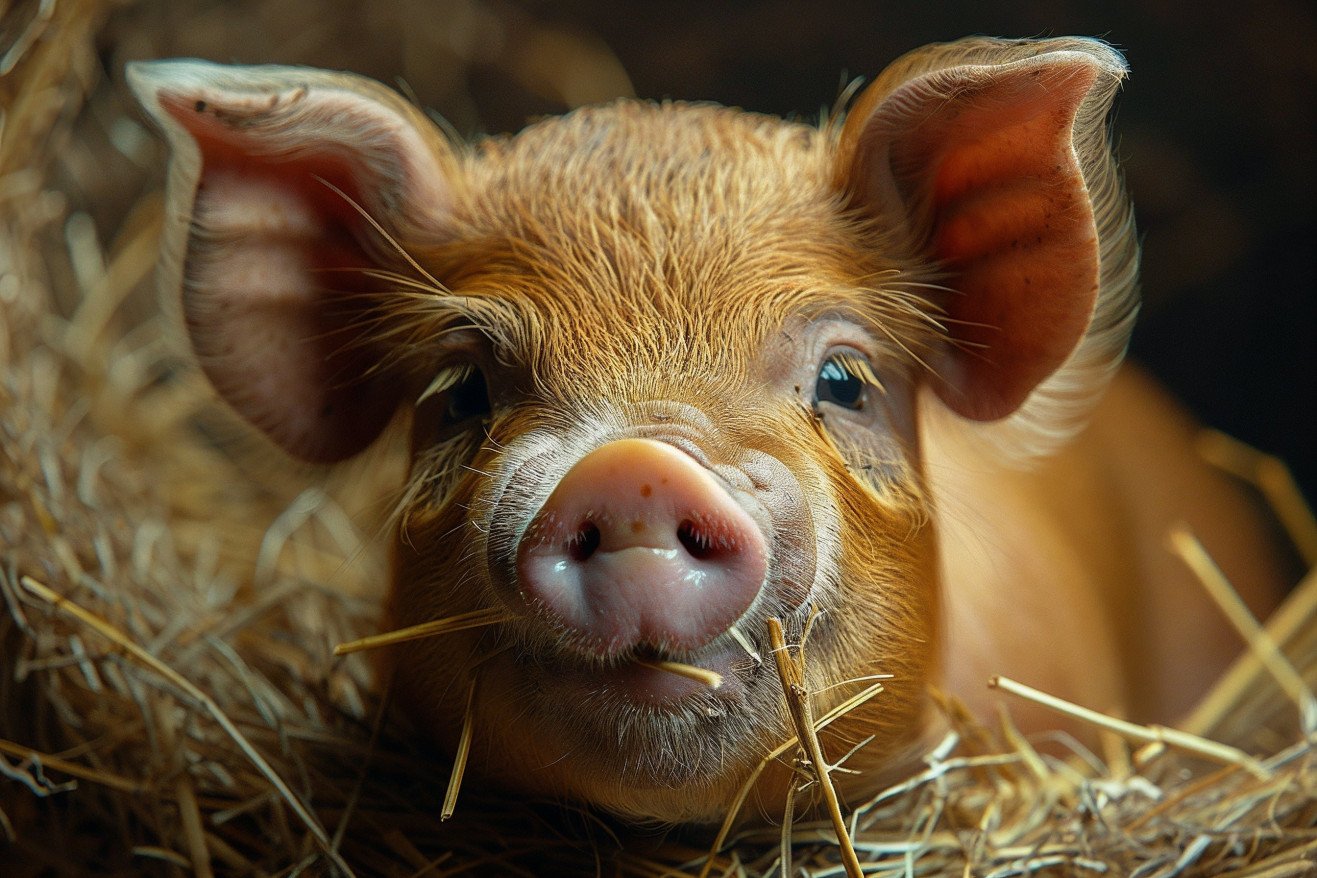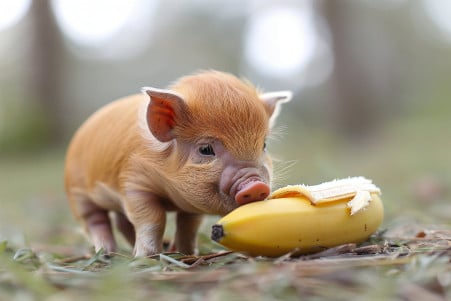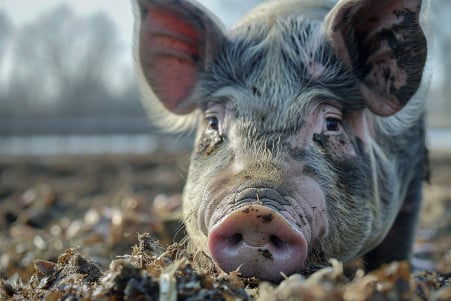Do Pigs Eat Hay? A Look at Fiber Requirements and Enrichment
5 May 2024 • Updated 3 May 2024

How much hay, a fiber-rich food, should you be giving your homestead pigs, and is it even necessary? While hay can be used to supplement pigs' diets and even provide enrichment through foraging behavior, pigs can't survive on hay alone. Pigs are omnivores and need a diet that includes protein, fat, carbohydrates, vitamins, and minerals, as well as fiber.
In this article, we'll explore scientific research and expert opinions to answer the question of whether pigs eat hay in the wild and on the farm. This research covers topics such as the pig's digestive system, the nutritional needs of pigs at different life stages, and environmental enrichment for pigs that can help ensure good pig welfare. By learning about the role hay can play, we can better meet the needs of these intelligent farm animals.
Do pigs eat hay?
Meeting the Nutritional Needs of Pigs and Creating Balanced Diets
Pigs need a high-energy, high-protein diet that includes essential amino acids, minerals, and vitamins to grow and thrive. However, the exact nutritional needs of pigs can vary based on a number of factors, including age, genetics, reproductive status, and the environment, according to the University of New Hampshire Extension.
Pig feed is most often corn-based and includes soybean meal to meet protein needs, as well as vitamins and minerals to make a complete ration. As the American Hampshire Pig Breeders Association explains, these feeds are high in nutrients and are designed to meet the needs of each growth stage, which helps prevent the excretion of excess nutrients that can have negative environmental impacts.
Farmers work with nutritionists to create rations that are balanced to meet their pigs' specific needs. This ensures that the pigs' nutritional needs are met at each stage of life, from the energy-rich creep feed that piglets eat while they're nursing to the high-protein grower rations and nutrient-rich finisher feeds that pigs eat later in life, according to the Agriculture and Horticulture Development Board.
While other feedstuffs like hay can potentially be used, it's important that they're only included in the diet if they're balanced out by other feedstuffs and meet the pigs' nutritional needs, which can be accomplished with careful planning and the help of a nutritionist, according to the Alabama Cooperative Extension. By making sure that pigs are getting complete, balanced nutrition at each stage of life, farmers can ensure that their pigs are as healthy and productive as possible.
Alfalfa and Clover Hay for Pigs
Alfalfa and clover hay are high-quality options that can offer protein, vitamins, and good fiber for pigs, as noted by Wrong Direction Farm. That said, pigs may prefer lower-quality, weathered hay because they can pick and choose what they eat based on the nutritional content. In the Wrong Direction Farm study, the pigs appeared to be rooting through the hay to find the most nutritious leaves and stems.
For winter feeding, Thrifty Homesteader discovered that alfalfa pellets can be a more cost-effective and less wasteful option than feeding loose hay. The pellets are soaked in water to make them more palatable, and the pigs eat them after they've absorbed the water and expanded. However, the A Greener World points out that the nutritional content of alfalfa can change based on maturity, soil fertility, and processing, which can affect its use for pigs.
Mixing forages may also help reduce the need for grain while giving pigs a more varied diet, according to the A Greener World study. These diverse forage mixtures, which include grasses, legumes, and other forages, may allow pigs to get more of their nutritional needs met through grazing.
Benefits and Limitations of Adding Hay to Pig Diets
Hay can be a valuable source of fiber that can improve gut health and sow well-being, and it may even help reduce feed costs, according to a study that looked at the nutritional quality of alfalfa. In fact, alfalfa hay, in particular, has been found to improve sow health, piglet growth, and pork quality.
On the other hand, feeding pigs high levels of hay can lead to reduced nutrient digestibility and growth performance, as reported in a paper that summarized the impacts of feeding high-fiber diets to swine. In addition, the introduction of hay into a pig's diet can be challenging due to the potential for food competition.
Other factors to keep in mind are the seasonality of hay and the increased energy needs of pigs on pasture, as explained in the Pork Information Gateway resource. While hay can be a valuable addition to a well-rounded pig diet if introduced and managed properly, farmers need to consider the potential benefits and limitations of adding it to their pigs' diets.
How to Train Pigs to Eat Hay
Two of the most important factors in training pigs to eat hay are to introduce it gradually and to make sure that each pig has access to it, according to the pigs forum at permies. In terms of the first factor, experts suggest that farmers start with a small amount of hay and then increase the amount over time so that the pigs can get used to it. In terms of the second factor, separate feeding stations can help make sure that all pigs get a chance to eat the hay without being bullied by other pigs, according to VCA Animal Hospitals.
Farmers can also encourage pigs to eat hay by adding foraging toys or rooting stations to their pens, which can help stimulate their natural instincts to graze and make the hay more appealing, according to VCA Animal Hospitals. Farmers should also monitor pigs' body condition, especially if they're an easy-keeper breed that's prone to obesity, and adjust the amount of hay they're given accordingly.
Finally, to make sure that pigs eat the hay and don't waste it, farmers can mix it with other feed or soak it in water to make it more appealing, according to the experiences shared in the pigs forum at permies. By training pigs to eat hay in a way that takes their individual needs and preferences into account, farmers can make sure that they get the benefits of hay without sacrificing their health and well-being.
Conclusion: Finding the Right Balance of Nutrition and Enrichment for the Best Pig Health
Pigs need a diet that is high in energy and protein and includes essential amino acids, minerals, and vitamins in order to grow and be productive. The exact nutritional needs of pigs depend on a variety of factors, including body weight, genetics, health, reproductive status, and environment, as noted by the Agriculture and Horticulture Development Board.
Most pig feed is based on corn and includes soybean meal to meet protein needs, as well as added vitamins and minerals to ensure a complete ration. These feeds are designed to be nutrient-dense and to meet the needs of each important growth stage, while also preventing the excretion of excess nutrients that can be harmful to the environment, according to the American Hampshire Pig Breeders Association.
Farmers work with nutritionists to make sure that the rations they feed their pigs are balanced and meet their pigs' specific needs. This includes making sure that the pigs' dietary needs are met at each life stage, from the energy-rich creep feed that piglets eat while they are nursing to the high-protein grower rations and nutrient-dense finisher feeds that pigs eat later in life, according to the Alabama Cooperative Extension. While hay or other alternative feedstuffs can be included, they can only be included if the overall ration is still balanced and if the farmer has worked with a nutritionist to make sure that the ration meets the pigs' needs.
By understanding the role of hay and making sure that both nutrition and environmental enrichment are prioritized, we can make sure that pigs are as healthy and happy as possible.


